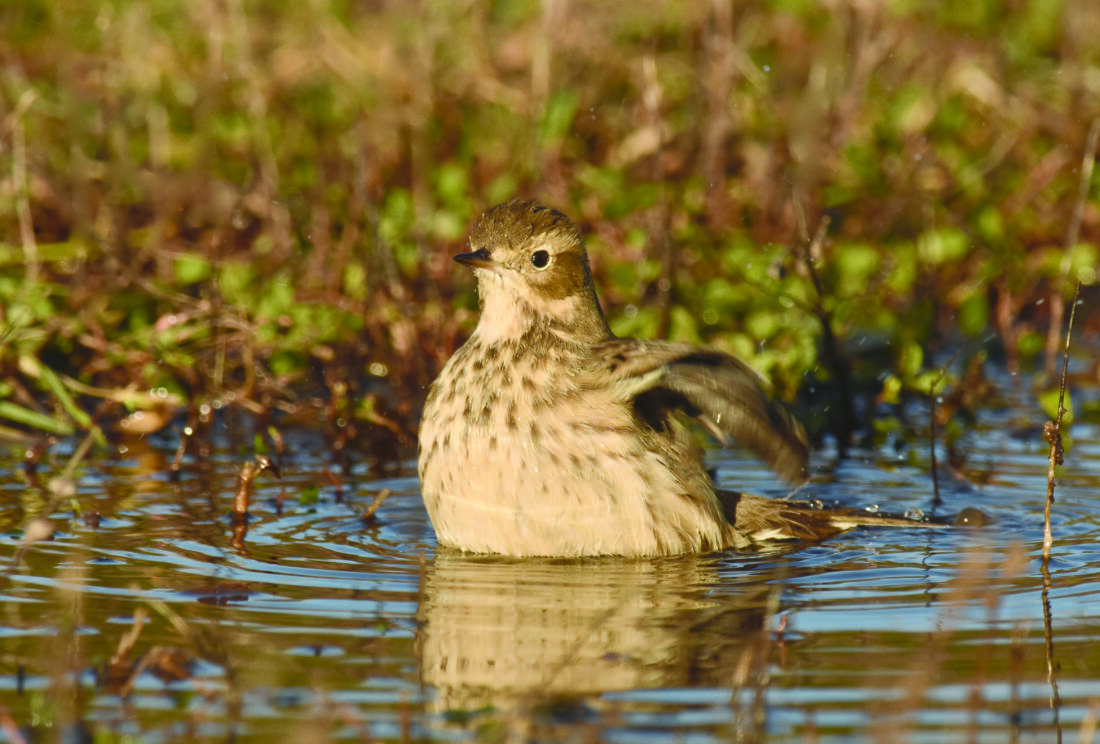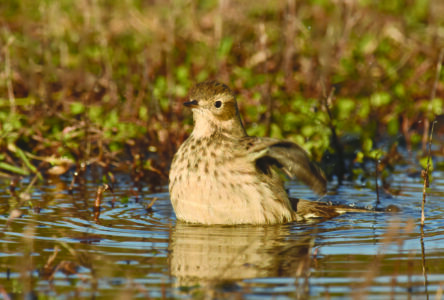What’s Flying: Fall colors nearing their peak

An American pipit bathes. (Photo by Scot Stewart)
“Ah, Lovely October, as you usher in the season that awakens my soul, your awesome beauty compels my spirit to soar like a leaf caught in an autumn breeze and my heart to sing like a heavenly choir.” – Peggy Toney Horton
Summer seems determined to strut its best just a little bit long. The past week autumn appeared to take a step back into August with warm temperatures and a streak of cloudless days. This period of dry conditions has put some of the local trees, especially basswoods, into a premature stage of browning, skipping some of the more artistic shades of golds and yellows. The clear skies may be keeping more of the migrant birds on a quicker pace to continue their southward flights.
Geese are definitely on the move with flights heard overhead and many small groups showing up on athletic fields and other manicured spots around Marquette. It is difficult to recognize most small flocks as either migrants or summer residents unless they contain other goose species. One flock in Marquette last week did contain a quartet of snow geese. They have not been reported on eBird in more than a week suggesting they may have already moved on.
However, a single adult white snow goose did appear with a smaller group of Canada geese last Tuesday on the north side of Marquette suggesting it arrived with another flock. The previously seen quartet consisted of one white adult snow goose with three juvenile geese making it seem unlikely they would have left the adult behind and left, or all been lost in Marquette due to predation or other causes.
At Whitefish Point small flocks of Canada geese are also passing over as they make their way south for the winter. Also seen there is the beginning of the transition from dabbling ducks to the divers. American wigeons, green-winged teals, and northern pintails are still flying past as scaup, scoters, redheads and larger flocks of red-breasted mergansers join in.

SCOT STEWART
At the harbors of Marquette green-winged teals and surf scoters have been seen too. Horned and red-necked grebes have been followed foraging in the Lower Harbor where they and diving duck numbers should begin to increase in the coming weeks. Last year a great array of redheads, scaup, horned grebes and bufflehead ducks were present on the south side of the ore dock with the resident common mergansers and eventually the overwintering common goldeneyes. Common loons, long-tailed ducks, rare to the area ruddy ducks, surf, black, and white-winged scoters may also be found there during the fall months. With the addition of the new piers in the Lower Harbor, along with the walkway at Matton Park, the Lower Harbor has become a premium location to watch waterbirds in Marquette. Spotting scopes and binoculars are extra helpful. Even a stroll down the Lower Harbor breakwall can provide some great views of the long-tail ducks and some of the grebes. Two autumns back an unusual eared grebe spent several days along the breakwall with several horned grebes for great views of this visitor to the area from the western states.
Weedy fields and open areas have provided foraging areas for American pipits, horned larks, and a smattering of sparrows, mostly white-crowned and white-throated. Both the pipits and horned larks have similarities in their ranges, spending summers in northern Alaska and winters in the Lower 48. Pipits have big gap between the two seasons with only migrators being seen in southern Canada and the northern tier of U.S. states for the pipits
Horned larks have a very interesting range across much of northern Canada and all of Alaska in the summer as well as a good chunk of the Lower 48 year-round. Their range doesn”t include the Upper Peninsula or the boreal forests of Canada, but they do migrate through the U.P., especially during fall migration. One even showed up on a Marquette Christmas bird count around 30 years ago. They do have a variety of forms with darker, brown backed birds sporting much yellow around their black masks. Light forms with tanner backs are trimmed with white around their masks.
The pipits and the horned larks are ground huggers when foraging in fields. This week a nice flock of horned larks foraged across the fields near the Superior Dome, with as many as 44 together there. A casual check may not turn up any birds, but a long binocular scan or a disturbance may provide evidence of their presence. Many times, they will flush, spin on a wide loop around a field and land again across a wide area away from a possible disturbance. When raptors like merlins and peregrines searching for a meal like a pipit or horned lark, or even a high-flying bald eagle just heading to another lake side spot, cruise overhead, the potential targets will first spot the potential threat overhead by tilting their heads to eye the bird from one side, then flatten themselves to take the lowest profile. American golden-plovers and black-bellied plovers may also show up in the same areas, especially after a good rain when the soil is soft and worms are near the surface to forage on them, grasshoppers, and other arthropods.
There may still be time to check area American mountain ash trees for signs of late robins, Swainson’s and gray-cheeked thrushes, and even eastern blue birds still heading south. Eight bluebirds were spotted in Negaunee Township last Tuesday. With
- An American pipit bathes. (Photo by Scot Stewart)
- SCOT STEWART


